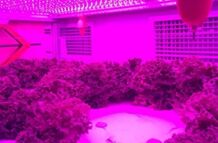改革印记:“带电栽培”助力中国新农业革命
|
也许有一天,你能在自家的厨房和阳台,用电栽培果蔬,整洁卫生又能防病虫害。媒体报道称,新的带电栽培技术提高了中国蔬菜大棚的产量,还降低了化肥和农药的使用量,助力了中国新农业革命。 Chinese growers have the answer to a question that has been baffling scientists for three centuries: Can electricity boost plant growth? 电能促进植物生长吗?对于这个困扰了科学家三个世纪的问题,中国的种植户们有了答案。
To find out, China has been conducting the world’s largest experiment and the results are transforming agricultural production in the world’s most populous nation with a jolt. 为了找到答案,中国一直在进行世界上最大规模的试验,其结果将为这个世界人口大国的农业生产带来巨变。 Across the country, from Xinjiang’s remote Gobi Desert to the developed coastal areas facing the Pacific Ocean, vegetable greenhouse farms with a combined area of more than 3,600 hectares have been taking part in an “electro culture” program funded by the Chinese government. 在全国各地,从新疆偏远的戈壁沙漠到面朝太平洋的沿海发达地区,总面积超过3600公顷的蔬菜大棚正在参与中国政府资助的一项“带电栽培”计划。 Last month the Chinese Academy of Agricultural Sciences and other government research institutes released the findings of nearly three decades of study in areas with different climate, soil conditions and plantation habits. They are hailing the results as a breakthrough. 上个月,中国农业科学院和其他政府研究机构发布了对气候、土壤条件和种植习惯不同的地区近30年研究的结果,他们称结果具有突破性。 The technique has boosted vegetable output by 20 to 30 percent. Pesticide use has decreased 70 to 100 percent. And fertilizer consumption has dropped more than 20 percent. 这项技术使蔬菜产量提高了20%至30%,农药使用量减少了70%至100%,化肥消耗量下降了20%以上。 The vegetables grow under bare copper wires, set about three metres above ground level and stretching end to end under the greenhouse roof. The wires are capable of generating rapid, positive charges as high as 50,000 volts, or more than 400 times the standard residential voltage in the US. 这些蔬菜生长在裸铜线下,铜线高出地面约3米,在温室大棚顶下首尾相连。这些铜线能够产生高达5万伏的快速正电荷,相当于美国标准住宅电压的400多倍。 The high frequency electricity kills bacteria and virus-transmitting diseases in the air or soil. It also suppresses the surface tension of water on leaves, accelerating vaporization. 高频电流能够杀死空气或土壤中的细菌和病毒,从而抑制疾病传播,它还能抑制叶片水分的表面张力,使其加速蒸发。 Within the plants, the transport of naturally charged particles, such as bicarbonate and calcium ions, speed up and metabolic activities, like carbon dioxide absorption and photosynthesis, also increase. 而在植物内部,碳酸氢根离子和钙离子等天然带电粒子的运输速度加快,二氧化碳吸收和光合作用等代谢活动也在增加。 Professor Liu Binjiang, agriculture scientist and a leading member of the project, said the electric current flowing through the wires is only a few millionths of an ampere by volume – lower than a smartphone cable’s workload. 农业科学家、该项目的主要成员刘滨疆教授说,裸铜线中的电流只有百万分之几安培,比智能手机电线的负荷还要低。 “It does absolutely no harm to the plants or to humans standing nearby,” he said. 他说:“带电栽培对蔬菜和站在近旁的工作人员完全无害。” Thanks to the positive findings of the study, the area devoted to electrified farms in China is now growing with uNPRecedented speed, according to Liu, from 1,000 to 1,300 hectares each year. 刘滨疆教授说,得益于这项研究的积极成果,中国带电栽培农场的面积正在以前所未有的速度增长,每年增加1000至1300公顷。 That means up to 40 percent growth in electro culture farming could be achieved within the next 12 months. 这意味着,在未来12个月内,中国带电栽培的增长率可达40%。 “Most recent investments have come from the private sector,” Liu said. “The business is taking off. We are supplying the technology and equipment to other countries including the Netherlands, United States, Australia and Malaysia. 刘滨疆教授说:“最近的投资大多来自私营领域,业务正在飞速增长。我们正在向荷兰、美国、澳大利亚和马来西亚等其他国家提供技术和设备。” The British and American authorities each commissioned separate studies on electro culture in the early 20th century. The British findings were positive, while the American results were negative. 20世纪初,英国和美国当局分别开展带电栽培的研究,英国的研究结果是正面的,而美国的结果则是负面的。 These experiments were mostly small and conducted in open fields, with conditions which varied from one location to another. The wide range of natural elements affected the final output and there was no universal standard for hardware design or technical details such as voltage and frequency. 那些试验大多规模较小,而且是在空旷的田野进行的,条件因地而异。各种自然因素影响着最终结果,而且在硬件设计或技术细节(比如电压和电频)等方面也没有通用的标准。 The scientists in these pioneering studies also lacked advanced equipment, such as today’s portable spectrum analyzer, to study the plant’s response to electricity at the molecular level. 从事这些开创性研究的科学家也缺乏先进设备,比如当今的便携式频谱分析仪,来研究植物在分子层面上对电的反应。 As a consequence, explanations of the observed phenomenon remained speculative and interest waned with the advent of chemical fertilizers and pesticides to achieve mass agricultural production. 因此,对实验观察结果的解释仍然是推测性的。随着化肥和杀虫剂的出现,农业实现了大规模生产,人们对带电栽培的兴趣逐渐消退。 Public interest in electro culture revived with the rise of organic farming and the Chinese government started funding experiments in the technique in 1990. 但在有机农业兴起之后,人们对带电栽培恢复了兴趣,中国于1990年开始资助这项技术的试验。 He Feng, senior technician of Yufa Jingnan Vegetable Production and Sales, one of Beijing’s largest vegetable producers, said the company had taken part in the program since 2014 and the results were “very satisfactory”. 北京最大的蔬菜生产企业之一榆垡京南蔬菜产销专业合作社的高级技术员何峰(音)说,该公司自2014年以来一直参与这项计划,结果“非常令人满意”。 In just two years the electrified vegetables had brought in extra revenue of nearly 1.2 million yuan. 仅仅两年时间,带电栽培蔬菜就增收近120万元人民币。 “We are still running the equipment, which consumes very little power,” he said. 他说:“我们还在使用那些设备,耗电很少。” One hectare of electrified greenhouse requires about 15 kilowatt-hours of electricity per day, which is about half the power usage of an average American family. 一公顷的带电栽培温室大棚每天需要用电大约15千瓦时,大约是美国一个普通家庭每天用电量的一半。 Inside the greenhouse the air smells like the aftermath of a summer thunderstorm. Humidity is low and the plants rarely get sick. 在温室大棚里,空气中弥漫着夏天雷雨过后的味道。湿度低,植物很少患病虫害。 The biggest burden is the installation cost, He said, with the necessary hardware costing tens of thousands of yuan. Without government support, the company could not have afforded to wire up all its greenhouses. 何峰说,最大的负担是安装费用,所需的硬件成本达数万元。如果没有政府的支持,该公司没有财力让所有的大棚都实现带电栽培。 Liu Yongyi, owner of City Luhai Xinghua Sightseeing Agriculture company in Beijing’s Daxing district, which is also engaging in electro culture, said the technology would significantly improve China’s food safety by massively reducing the use of pesticides. 北京市大兴区都市绿海兴华观光农业有限公司也在从事带电栽培,该公司老板刘永义(音)说,这项技术将大大减少农药的使用,从而提高中国的食品安全水平。 “Pesticide residue is a huge threat to public health. Electricity provides a physical solution to disease and pest control. It is much cleaner than chemicals. The government should subsidize the electro culture revolution,” he said. 他说:“农药残留是对公众健康的巨大威胁,电力为控制病虫害提供了物理解决方案,它比化学品干净得多,政府应该补贴带电栽培革命。” Liu said visitors to the farm were intrigued when they saw the system at work and he believed the public would be quick to embrace the technology. 他说,参观农场的人们看到这个系统时都很好奇,他相信公众会很快接受这项技术。 “The theory is easy to understand. I believe people would be willing to pay a premium for electrified vegetables and fruits in the near future,” he said. 他说:“这个理论很容易理解。我相信,在不久的将来,人们会愿意为带电栽培的蔬菜和水果支付更高的价格。” Professor Liu said there were no plans to electrify them all, as the investment would be unaffordable for most farmers. 刘滨疆教授说,目前还没有给所有温室大棚通电的计划,因为大多数农民负担不起这笔投资。 His project team is taking a different approach and developing a compact, all-in-one vegetable growing chamber using electro culture technology. 因此他的项目组正在采取另一种方法:利用带电栽培技术开发一个紧凑的、一体化的蔬菜种植室。 “Each family would be able to grow their own food in the kitchen, on the balcony or in the backyard,” he said. 刘滨疆说:“每个家庭都能在厨房、阳台或后院种植自己的食物。” The chamber uses an artificial light source and electric field to stimulate plant growth and prevent diseases. Operation is automatic and almost care and maintenance free. 这个种植室利用人工光源和电场来刺激植物生长和预防疾病,操作全自动化,几乎不需要料理和维护。 “One day these tiny chambers may become an alternative to large scale farms,” Liu said. “That would trigger another agricultural revolution.” 他说:“有朝一日,这些小种植室可能会替代大型农场,那将引发另一场农业革命。” |









